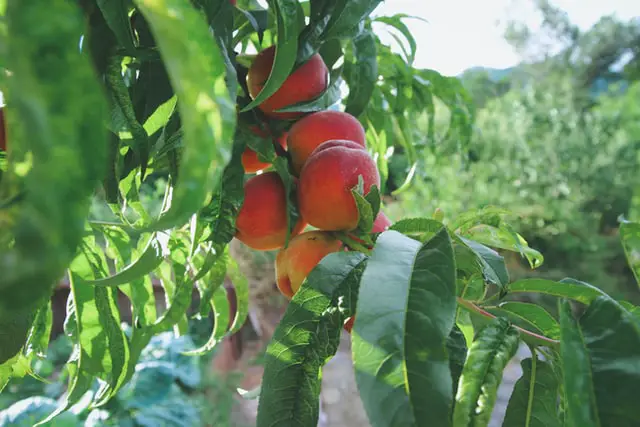We do not all have the luxury of a large garden, but that doesn’t mean you cannot successfully grow fruit trees. Patio nectarine trees are compact in size which makes them perfect for your modest garden space. A big plus is that they do not need much care throughout the year and you can enjoy the pretty pink blossom during the Spring.

After the colourful spring flowers, you can wait eagerly for signs of the succulent nectarines appearing. A highly decorative tree, nectarine trees in pots will be a pleasing addition to your patio area.
Enjoy the juicy nectarines straight from the tree in the late summer and they are perfect for desserts too. Patio nectarine trees will grow to around 1.2 metres which is a manageable height for a bijou garden. Once planted, you can expect your first crop in year two and the best yields by its fourth year.
Jump To...
Best Patio Nectarine Tree Varieties
There are a few popular nectarine varieties for patio spaces so we have narrowed down the search for you.
Below we share what UK gardeners are currently buying and having great successes with plus their key features.
Madame Blanchett
A fairly small nectarine, the Madame Blanchett is lovely and sweet and one bite will have the juice running down your chin.
They originate from Holland but prove very hardy against the UK weather – they have a good frost resistance too.
- Best Feature: Heavy cropper and frost resistant
- When To Plant Out: November to March
- Harvest Fruit: September
- Best Growing Position: Full sun
Prunus Persica
The Royal Horticultural Society (RHS) awarded Prunus Persica the Award of Garden Merit which measures the success of plants growing in UK conditions.
Nectarine trees in containers are perfect for beginner gardeners due to how low maintenance they are.
- Best Feature: Reliable and impressive cropping
- When To Plant Out: November to March
- Harvest Fruit: September
- Best Growing Position: Full sun with shelter available
Growing Nectarine Trees in Pots – Patio Care Guide
Growing nectarine trees in pots have become popular across the UK due to their easy care and hardiness. They remain at a manageable height and are extremely prolific fruiters when the right conditions are met. Read our top growing tips for more information on nectarine trees in containers.
- What Size Pot for a Nectarine Tree? 45cm in diameter
- Compost: Loam based potting compost
- Watering: Daily during its growing season
- Feeding: High potassium liquid feed two weekly
- Rootstock: Semi vigorous such as Torinel
Common Patio Nectarine Tree Problems
- Peach Leaf Curl: Affecting both peach and nectarine trees, peach leaf curl is quite easy to spot, fortunately. Leaves will take on a distorted appearance and will twist and take on a bubbly look. This is caused by fungal spores which are easily spread by moisture. The most effective form of treatment is to remove any affected foliage when it’s noticed.
- Greenfly: Many insects will be attracted to your nectarine tree but they do not all cause damage. Greenfly and other aphids can usually be spotted and will be predated by ladybirds and other creatures. Encourage natural predators by creating spaces for them to breed, such as ladybird houses.
Pruning Patio Nectarine Trees
Due to your nectarine tree being in a pot, any pruning will be minimal and not at all complex. A little pruning will encourage healthy shoots to grow and will encourage good cropping.
When to Prune Patio Nectarine Trees
For optimal results, you want to prune your patio nectarine tree during the spring. This will encourage strong growth of your buds which will lead to fruit in the second year.
How to Prune Patio Nectarine Trees
A low maintenance task, pruning your nectarine patio tree involves keeping the branches tidy and free from any overcrowding. Any branches no longer producing fruit should be taken off to allow for new young growth. You should aim to remove any damaged branches and buds too.
FAQ’s
Growing nectarine trees in containers is both popular and successful. They are a great solution when having a lack of space to work with and they produce decent crop sizes too.
A patio nectarine tree will stay at a modest height of 1.2 metres which will be good news for gardeners with busy lives. Any pruning it requires will be solely to remove any damaged branches, not to reduce its height.
When it comes to choosing compost for your patio nectarine tree, you will need to pick loam-based soil. Be sure to have good drainage too.
Your patio nectarine tree should begin producing fruit in its second year. If your patio nectarine shows no sign of fruiting then it may have been damaged by the frost. Pollination may also have been in short supply or perhaps inadequate pruning to encourage its growth.
Should you wish to overwinter your potted nectarine tree, then you will need some cover and a low temperature but not freezing. Spaces such as a garage shed, or conservatory may be suitable and they will not need much light during the winter months.
A pot size of 45cm will be suitable for nectarine trees and you will want to repot it every few years to ensure the environment stays healthy

